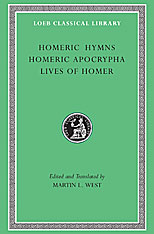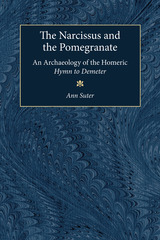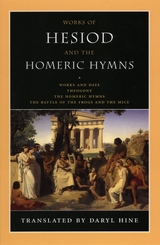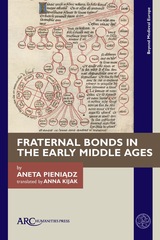

Hesiod (Hesiodus), an epic poet apparently of the eighth century BC, was born in Asia Minor but moved to Boeotia in central Greece. He was regarded by later Greeks as a contemporary of Homer.
Three works survive under Hesiod's name: (1) "Works and Days," addressed to his brother. In it he gives us the allegories of the two Strifes, and the myth of Pandora; stresses that every man must work; describes the accepted Five Ages of the world; delivers moral advice; surveys in splendid style a year's work on a farm; gives precepts on navigation; and propounds lucky and unlucky days. (2) "Theogony," a religious work about the rise of the gods and the universe from Chaos to the triumph of Zeus, and about the progeny of Zeus and of goddesses in union with mortal men. (3) "The Shield" (not by Hesiod), an extract from a "Catalogue of Women," the subject being Alcmena and her son Heracles and his contest with Cycnus, with a description of Heracles' shield. All three works are of great literary interest.

Invocations, curiosities, and biographies connected with the famous Greek bard.
Performances of Greek epics customarily began with a hymn to a god or goddess—as Hesiod's Theogony and Works and Days do. A collection of thirty-three such poems has come down to us from antiquity under the title “Hymns of Homer.” This Loeb Classical Library volume contains, in addition to the Hymns, fragments of five comic poems that were connected with Homer’s name in or just after the Classical period (but are not today believed to be by the author of the Iliad and the Odyssey). Here too is a collection of ancient accounts of the poet’s life.
The Hymns range widely in length: two are over 500 lines long; several run only a half dozen lines. Among the longest are the hymn to Demeter, which tells the foundational story of the Eleusinian Mysteries; and to Hermes, distinctive in being amusing. The comic poems gathered as Homeric Apocrypha include Margites, the Battle of Frogs and Mice, and, for the first time in English, a fragment of a perhaps earlier poem of the same type called Battle of the Weasel and the Mice. The edition of Lives of Homer contains The Contest of Homer and Hesiod and nine other biographical accounts, translated into English for the first time.
Martin West’s faithful and pleasing translations are fully annotated; his freshly edited texts offer new solutions to a number of textual puzzles.

The author analyzes the traditional language of the hymn and Persephone's retelling of her story to Demeter, arguing that the hymn involves an earlier tale of Demeter and Persephone that predates the seventh century. Suter uses anthropological applications to illustrate that the story of Persephone's abduction does not reflect a female initiation rite into adulthood, as has been argued, but rather an hieros gamos. These methodologies point to the conclusion that Persephone was once a powerful goddess in her own right, independent of Hades and of Demeter as well. To test the accuracy of these possibilities, the book next examines evidence from outside the hymn. Other versions of the two myths in the hymn support the idea that these myths--Persephone's abduction and Demeter's nursing of Demophoön--were once separate and were late combined to create a new story. Evidence from the chief archaeological sites, from vase painting and other artistic forms is provided to enhance the argument. Thus the evidence from outside the hymn supports the conclusions of the textual analyses, giving surprising substantiation that the hymn itself commemorates the early days of the worship of the goddesses as a mother/daughter pair.
This book will be of particular interest to scholars of religious history, art history, archaeology, and literature. It is also accessible to the general reader interested in Greek literature, myths, and religion.
Ann Suter is Associate Professor of Classical Studies, University of Rhode Island.

In Works of Hesiod and the Homeric Hymns, highly acclaimed poet and translator Daryl Hine brings to life the words of Hesiod and the world of Archaic Greece. While most available versions of these early Greek writings are rendered in prose, Hine's illuminating translations represent these early classics as they originally appeared, in verse. Since prose was not invented as a literary medium until well after Hesiod's time, presenting these works as poems more closely approximates not only the mechanics but also the melody of the originals.
This volume includes Hesiod's Works and Days and Theogony, two of the oldest non-Homeric poems to survive from antiquity. Works and Days is in part a farmer's almanac—filled with cautionary tales and advice for managing harvests and maintaining a good work ethic—and Theogony is the earliest comprehensive account of classical mythology—including the names and genealogies of the gods (and giants and monsters) of Olympus, the sea, and the underworld. Hine brings out Hesiod's unmistakable personality; Hesiod's tales of his escapades and his gritty and persuasive voice not only give us a sense of the author's own character but also offer up a rare glimpse of the everyday life of ordinary people in the eighth century BCE.
In contrast, the Homeric Hymns are more distant in that they depict aristocratic life in a polished tone that reveals nothing of the narrators' personalities. These hymns (so named because they address the deities in short invocations at the beginning and end of each) are some of the earliest examples of epyllia, or short stories in the epic manner in Greek.
This volume unites Hine's skillful translations of the Works of Hesiod and the Homeric Hymns—along with Hine's rendering of the mock-Homeric epic The Battle of the Frogs and the Mice—in a stunning pairing of these masterful classics.
READERS
Browse our collection.
PUBLISHERS
See BiblioVault's publisher services.
STUDENT SERVICES
Files for college accessibility offices.
UChicago Accessibility Resources
home | accessibility | search | about | contact us
BiblioVault ® 2001 - 2024
The University of Chicago Press









